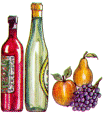 |

About Food Resources
The Making of the Landscape
There is a multitude of species of plants and animals that provide us with food which is an important part of of the planet's biodiversity. The Earth's food resources can be divided into two main groups :
1. Vegetables
Cocoa, tea, coffee

These tropical or subtropical crops are grown mainly for export to the economically advanced countries. Tea and coffee are the world's principal beverages. Cocoa is used more in the manufacture of chocolate.
Sugar beat, Sugar cane

Sugar cane, which is a tropical crop, accounts for the bulk of the sugar entering into international trade. Beet sugar, on the other hand, demands a temperate climate and is produced primarily for domestic consumption.
Vegetable oilseeds and oils

Groundnuts are also a valuable subsidence crop and the meal is used as animal feed. Soya bean meal is a growing source of protein for humans and animals. The Mediterranean lands are the prime source of olive oil.

Despite the increasing use of syntheticchemical products and animal and marine fats, vegetable oils extracted from these crops grow in quantity, value and importance. Food is the major use-in margarine and cooking fats.
Fruit, wine

With the imporvements in canning, drying and freezing, and in transport and marketing, the international trade and consumption of deciduous and soft fruits, citrus fruits and tropical fruits has greatly increased. Recent developments in the use of the peel will give added value to some of the fruit crops.
Over 80% of grapes are grown for wine and over a half in countries bordering the Mediterranean.
Cereals
Cereals include those members of the grain family with starchy edible seeds :
Maize (or corn)

|
Needs plenty of sunshine, summer rain or irrigation and frost free for 6 months. Important as animal feed and for human food in Africa, Latin America and as a vegetable and breakfast cereal.
|
Barley

|
Has the widest range of cultivation requiring only 8 weeks between seed time and harvest. Used mainly as animal-feed and by the malting industry.
|
Oats

|
Widely grown in temperate regions with the limit fixed by early autumn frosts. Mainly fed to cattle. The best quality oats are used for oatmeal, porridge and breakfast foods.
|
Rice

|
Needs plains or terraces which can be flooded and abundant water in the growing season. The staple food of half the human race. In the husk, it is known as paddy.
|
Wheat

|
The most important grain crop in the temperate regions though it is also grown in a variety of climates (example, in Monsoon lands as a winter crop).
|
Rye

|
The hardiest of cereals and more resistant to cold, pests and disease than wheat. An important foodstuff in Central and Eastern Europe and the Soviet Republic.
|
Millets

|
The name given to a number of related members of the grass family of which sorghum is one of the most important. They provide nutritious grain.
|
Potato

|
An important food crop though less nutritous weight for weight than grain crops.
|
Cereals and potatoes (not a cereal but starch producing) are the principal source of food for our modern civilisations because of their high yield in bulk and food value per unit of land and labour required. They are also easy to store and transport, and provide food also for animals prodicing meat, fat, milk and eggs. Wheat is the principal bread grain of the temperate regions in which potatoes are the next most important food source. Rice is the principal cereal in the hotter, humid regions, especially in Asia. Oats, barley and maize are grown mainly for animal feed; millets and sorghums as amin subsistence crops in Africa and India.
2. Animals
Meat, milk and allied foods are prime protein-providers and are also sources of essential vitamins. Meat is mainly a product of continental and savannah grasslands and the cool west coasts particularly in Europe. Milk and cheese, eggs and fish - though found in some quantity throughout the world - are primarily a product of the temperate zones.
Beef cattle

|
Australia, New Zealand and Argentina provide the major part of international beef exports. Western U.S.A. and Europe have considerable production of beef for their local high demand.
|
Dairy cattle

|
The need of herds for a rich diet and for nearby markets result in dairying being characteristic of densely populated areas of the temperate zones - U.S.A., North Western Europe, New Zealand and South Eastern Australia.
|
Sheep

|
Raised mostly for wool and meat, the skins and cheese from their milk are important products in some countries. The merino yields a fine wool and crossbreds are best for meat.
|
Pigs

|
Can be reared in most climates from monsoon to cool temperate. They are abundant in China, the corn belt of the U.S.A., North Western and Central Europe, Brazil and the Soviet Republic.
|
Fish

|
Commercial fishing requires large shoals of fish of one species within reach of markets. Freshwater fishing is also important. A rich source of protein, fish will become an increasingly valuable food source.
|
Cheese

|
The principal producers are the U.S.A., Western Europe, Soviet Republic, and New Zealand and principal exporters Netherlands, New Zealand, Denmark and France.
|
Butter (includes Ghee)

|
The biggest producers are the Soviet Republic, India, U.S.A., and France.
|


© Copyright 2002, 2003 Seelendran Naidoo
All rights reserved.
|